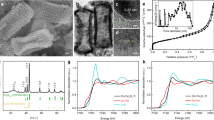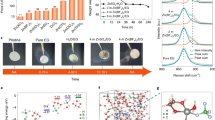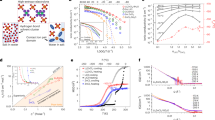Abstract
Rechargeable zinc–air batteries (ZABs) are considered to be one of the most sustainable alternative systems in a post-lithium-ion future owing to their lowest possible dependency on critical raw materials and high theoretical energy densities. However, their performance is still not up to par with their potential because of the sluggish kinetics of the oxygen reduction reaction. Here we report a single-atom catalyst design that transforms the sluggish four-electron oxygen reduction reaction into a fast two-electron pathway and enables a zinc peroxide (ZnO2) chemistry in ZABs. With accessible FeN2S2 active sites on mesoporous graphene, the catalyst serves to promote transport of electrolyte, oxygen and electron and confines the growth of ZnO2, which would otherwise form dead products. As a result, as-fabricated ZAB in a neutral electrolyte shows a voltage as high as 1.2 V at 0.2 mA cm−2, a high round-trip efficiency of 61% and an excellent operation stability beyond ∼400 h. This work provides guidelines for the rational design of multifunctional cathodes and would accelerate the adoption of sustainable batteries in the metal–air category.
This is a preview of subscription content, access via your institution
Access options
Access Nature and 54 other Nature Portfolio journals
Get Nature+, our best-value online-access subscription
$29.99 / 30 days
cancel any time
Subscribe to this journal
Receive 12 digital issues and online access to articles
$119.00 per year
only $9.92 per issue
Buy this article
- Purchase on Springer Link
- Instant access to full article PDF
Prices may be subject to local taxes which are calculated during checkout





Similar content being viewed by others
Data availability
All data in this work are available in the text and Supplementary Information. The relevant raw data for each figure or table (in the text and Supplementary Information) are listed in Excel documents and provided as source or supplementary data files. Source data are provided with this paper.
References
Peng, Z., Freunberger, S. A., Chen, Y. & Bruce, P. G. A reversible and higher-rate Li–O2 battery. Science 337, 563–566 (2012).
Bauer, C. et al. Charging sustainable batteries. Nat. Sustain. 5, 176–178 (2022).
Fu, J. et al. Electrically rechargeable zinc–air batteries: progress, challenges, and perspectives. Adv. Mater. 29, 1604685 (2017).
Li, Y. & Dai, H. Recent advances in zinc–air batteries. Chem. Soc. Rev. 43, 5257–5275 (2014).
Fu, J. et al. Recent progress in electrically rechargeable zinc–air batteries. Adv. Mater. 31, 1805230 (2019).
Seh, Z. W. et al. Combining theory and experiment in electrocatalysis: insights into materials design. Science 355, eaad4998 (2017).
Xia, B. Y. et al. A metal–organic framework-derived bifunctional oxygen electrocatalyst. Nat. Energy 1, 1–8 (2016).
Li, B. et al. Framework-porphyrin-derived single-atom bifunctional oxygen electrocatalysts and their applications in Zn–air batteries. Adv. Mater. 31, 1900592 (2019).
Xiao, M. et al. Preferentially engineering FeN4 edge sites onto graphitic nanosheets for highly active and durable oxygen electrocatalysis in rechargeable Zn–air batteries. Adv. Mater. 32, 2004900 (2020).
Li, A. et al. Interfacial defect engineering for improved portable Zinc–air batteries with a broad working temperature. Angew. Chem. Int. Ed. 58, 9459 (2019).
Chao, D. et al. Roadmap for advanced aqueous batteries: from design of materials to applications. Sci. Adv. 6, eaba4098 (2020).
Wang, F. et al. Highly reversible zinc metal anode for aqueous batteries. Nat. Mater. 17, 543–549 (2018).
Winter, M., Barnett, B. & Xu, K. Before Li ion batteries. Chem. Rev. 118, 11433–11456 (2018).
Zhao, Y. X. et al. A ‘pre-division metal clusters’ strategy to mediate efficient dual-active sites ORR catalyst for ultralong rechargeable Zn–air battery. Angew. Chem. Int. Ed. 62, e202216950 (2023).
Wang, Z. et al. A metal–organic framework host for highly reversible dendrite-free zinc metal anodes. Joule 3, 1289–1300 (2019).
Hou, Y. et al. MBene promoted Zn peroxide chemistry in rechargeable near-neutral Zn–air batteries. Energy Environ. Sci. 16, 3407–3415 (2023).
Sun, W. et al. A rechargeable zinc-air battery based on zinc peroxide chemistry. Science 371, 46–51 (2021).
Zhou, T. et al. Surface/interface nanoengineering for rechargeable Zn–air batteries. Energy Environ. Sci. 13, 1132–1153 (2020).
Wang, X.-T. et al. Redox-inert Fe3+ ions in octahedral sites of Co–Fe spinel oxides with enhanced oxygen catalytic activity for rechargeable zinc–air batteries. Angew. Chem. Int. Ed. 131, 13425 (2019).
Li, Y. et al. Advanced zinc–air batteries based on high-performance hybrid electrocatalysts. Nat. Commun. 4, 1805 (2013).
Thomas Goh, F. W. et al. A near-neutral chloride electrolyte for electrically rechargeable zinc–air batteries. J. Electrochem. Soc. 161, 2080 (2014).
Sun, W. et al. A non-alkaline electrolyte for electrically rechargeable zinc–air batteries with long-term operation stability in ambient air. Angew. Chem. Int. Ed. 61, e202207353 (2022).
Li, A. et al. Heterostructure-promoted oxygen electrocatalysis enables rechargeable zinc–air battery with neutral aqueous electrolyte. J. Am. Chem. Soc. 140, 17624–17631 (2018).
Lu, J. et al. Aprotic and aqueous Li–O2 batteries. Chem. Rev. 114, 5611–5640 (2014).
Shui, J. et al. Nitrogen-doped holey graphene for high-performance rechargeable Li–O2 batteries. ACS Energy Lett. 1, 260–265 (2016).
Dong, Q. et al. Cathodically stable Li–O2 battery operations using water-in-salt electrolyte. Chem 4, 1345–1358 (2018).
Yang, Y. et al. Metal surface and interface energy electrocatalysis: fundamentals, performance engineering, and opportunities. Chem 4, 2054–2083 (2018).
Luo, M. et al. Interface engineering of air electrocatalysts for rechargeable zinc–air batteries. Adv. Energy Mater. 11, 2002762 (2021).
Wang, X. R. et al. Identifying the key role of pyridinic‐N–Co bonding in synergistic electrocatalysis for reversible ORR/OER. Adv. Mater. 30, 1800005 (2018).
Jin, Z. et al. Understanding the inter-site distance effect in single-atom catalysts for oxygen electroreduction. Nat. Catal. 4, 615–622 (2021).
Zhao, M. et al. A pH-universal ORR catalyst with single-atom iron sites derived from a double-layer MOF for superior flexible quasi-solid-state rechargeable Zn–air batteries. Energy Environ. Sci. 14, 6455–6463 (2021).
Liu, K. et al. Insights into the activity of single-atom Fe–NC catalysts for oxygen reduction reaction. Nat. Commun. 13, 2075 (2022).
Lei, X. et al. High-entropy single-atom activated carbon catalysts for sustainable oxygen electrocatalysis. Nat. Sustain. 6, 816–826 (2023).
San Roman, D. et al. Engineering three-dimensional (3D) out-of-plane graphene edge sites for highly selective two-electron oxygen reduction electrocatalysis. ACS Catal. 10, 1993–2008 (2021).
Yang, X. et al. Tuning two‐electron oxygen‐reduction pathways for H2O2 electrosynthesis via engineering atomically dispersed single metal site catalysts. Adv. Mater. 34, 2107954 (2022).
Li, L. et al. Hierarchical pore-in-pore and wire-in-wire catalysts for rechargeable Zn– and Li–air batteries with ultra-long cycle life and high cell efficiency. Energy Environ. Sci. 8, 3274–3282 (2015).
Jiang, K. et al. Highly selective oxygen reduction to hydrogen peroxide on transition metal single atom coordination. Nat. Commun. 10, 3997–4006 (2019).
Tang, C. et al. Tailoring acidic oxygen reduction selectivity on single-atom catalysts via modification of first and second coordination spheres. J. Am. Chem. Soc. 143, 7819–7827 (2021).
Zhang, X. et al. Developing Ni single-atom sites in carbon nitride for efficient photocatalytic H2O2 production. Nat. Commun. 14, 7115 (2023).
Jiang, R. et al. Edge-site engineering of atomically dispersed Fe–N4 by selective C–N bond cleavage for enhanced oxygen reduction reaction activities. J. Am. Chem. Soc. 140, 11594–11598 (2018).
Liu, C. et al. Constructing FeN4/graphitic nitrogen atomic interface for high-efficiency electrochemical CO2 reduction over a broad potential window. Chem 7, 1297–1307 (2021).
Liu, S. et al. Atomically dispersed iron sites with a nitrogen–carbon coating as highly active and durable oxygen reduction catalysts for fuel cells. Nat. Energy 7, 652–663 (2022).
Liu, S., Shi, Q. & Wu, G. Solving the activity–stability trade-off riddle. Nat. Catal. 4, 6–7 (2021).
Zhao, J. et al. Key roles of surface Fe sites and Sr vacancies in the perovskite for an efficient oxygen evolution reaction via lattice oxygen oxidation. Energy Environ. Sci. 15, 3912–3922 (2022).
Cao, L. et al. Identification of single-atom active sites in carbon-based cobalt catalysts during electrocatalytic hydrogen evolution. Nat. Catal. 2, 134–141 (2019).
Cheng, W. et al. Lattice-strained metal–organic-framework arrays for bifunctional oxygen electrocatalysis. Nat. Energy 4, 115–122 (2019).
Ko, Y. et al. Biological redox mediation in electron transport chain of bacteria for oxygen reduction reaction catalysts in lithium–oxygen batteries. Adv. Funct. Mater. 29, 1805623 (2019).
Acknowledgements
This work was supported by the National Key R&D Program of China (2022YFA1503501 to W.L. and 2021YFA1201900 to Fei W.), the National Nature Science Foundation of China (grant nos. 22088101 to D.Z., U21A20329 to W.L., 52261135631 to Fei W. and 22105041 to W.Z.), the Science and Technology Commission of Shanghai Municipality (21TQ1400100 to W.L. and 21511103300 to Fei W.), the Program of Shanghai Academic Research Leader (21XD1420800 to W.L.) and the Shanghai Pilot Program for Basic Research–FuDan University 21TQ1400100 (21TQ008 to W.L.). We acknowledge Y. Kong and M. Gao from University of Science and Technology of China and Dalian Institute of Chemical Physics, Chinese Academy of Sciences, respectively, for their valuable help and suggestions regarding theoretical simulations.
Author information
Authors and Affiliations
Contributions
W.L. and Fei W. conceived and designed the experiments and calculations. W.Z., N.W., K.Z., C.Y., Y.A., Fengmei W., Y.T., Yuzhu M., Yao M. X. Z., L.D. and D.C. fabricated the samples and conducted the structure characterization and electrochemical experiments. J.Z. and K.Z. performed the synchrotron-based characterizations. W.Z., J. Z., N.W., W.L., Fei W. and D.Z. wrote the paper. All authors discussed the results and commented on the paper.
Corresponding authors
Ethics declarations
Competing interests
The authors declare no competing interests.
Peer review
Peer review information
Nature Sustainability thanks Minghao Yu, Xinbo Zhang and the other, anonymous, reviewer(s) for their contribution to the peer review of this work.
Additional information
Publisher’s note Springer Nature remains neutral with regard to jurisdictional claims in published maps and institutional affiliations.
Supplementary information
Supplementary Information
Supplementary experimental section, Figs. 1–56 and Tables 1–7.
Supplementary Data 1
All source data for supplementary figures.
Source data
Source Data Fig. 1
Corresponding height profiles of the meso-FeNSC. XANES, FT-EXAFS and WT contour plot spectra at the Fe K edge of Fe foil, FePc, FeS, Fe2O3 and the meso-FeNSC. The corresponding EXAFS fitting curves of the meso-FeNSC in R space.
Source Data Fig. 2
Voltammograms in O2-saturated 0.1 M PBS at 10 mV s−1. LSV curves together with the corresponding H2O2 currents on the ring electrode recorded at 1,600 rpm in O2-saturated 0.1 M PBS. The calculated electron transfer number (n) and H2O2 selectivity (H2O2%) in O2-saturated 0.1 M PBS. The stability at a fixed disk potential of the meso-FeNSC at 0.35 V versus RHE in O2-saturated 0.1 M PBS. The free energy diagram of ORR processes on the meso-FeNSC and meso-FeNC catalysts.
Source Data Fig. 3
Galvanostatic charge–discharge profiles of neutral ZABs fabricated with SP, meso-C, meso-FeNC and meso-FeNSC. Galvanostatic voltage profiles of the neutral ZABs fabricated with meso-FeNSC in capacity fixed mode (fixed capacity 1 mAh cm−2) at current density of 0.2, 0.5, 1.0, 2.0 and 4.0 mA cm−2. The long-term cycling performance of neutral ZABs fabricated with meso-FeNSC at current density of 0.2 mA cm−2. A comparison of the discharge voltage of the 2e− ZABs in this work and other ZABs.
Source Data Fig. 4
The XANES spectra of meso-FeNSC discharged to different potentials. The fitted average oxidation states of Fe from XANES spectra. FT-EXAFS spectra and corresponding contour plots at the Fe K edge of the meso-FeNSC discharged to different potentials. EXAFS fitting curves for R space of the meso-FeNSC discharged to different potentials.
Rights and permissions
Springer Nature or its licensor (e.g. a society or other partner) holds exclusive rights to this article under a publishing agreement with the author(s) or other rightsholder(s); author self-archiving of the accepted manuscript version of this article is solely governed by the terms of such publishing agreement and applicable law.
About this article
Cite this article
Zhang, W., Zhang, J., Wang, N. et al. Two-electron redox chemistry via single-atom catalyst for reversible zinc–air batteries. Nat Sustain 7, 463–473 (2024). https://doi.org/10.1038/s41893-024-01300-2
Received:
Accepted:
Published:
Issue Date:
DOI: https://doi.org/10.1038/s41893-024-01300-2
This article is cited by
-
Single-atom catalysts for neutral zinc-air batteries
Science China Materials (2024)



